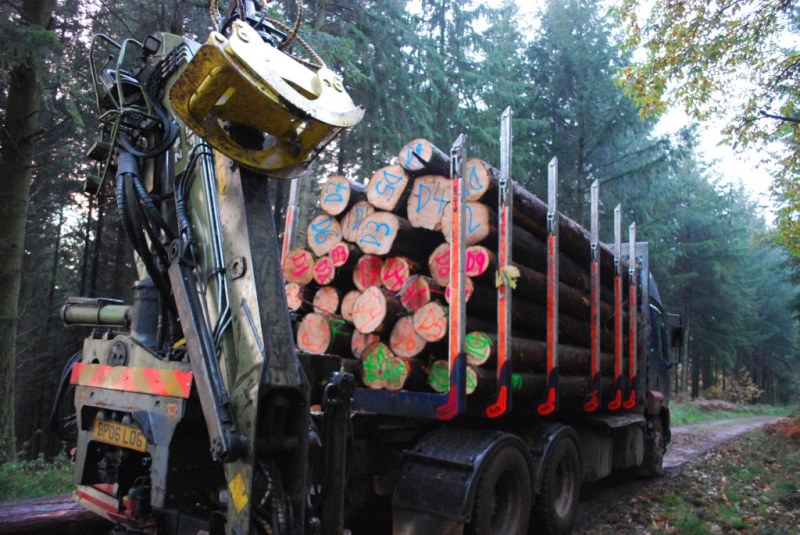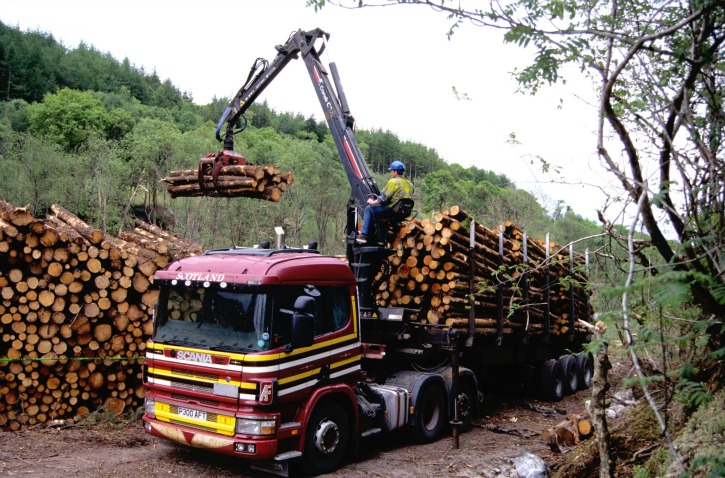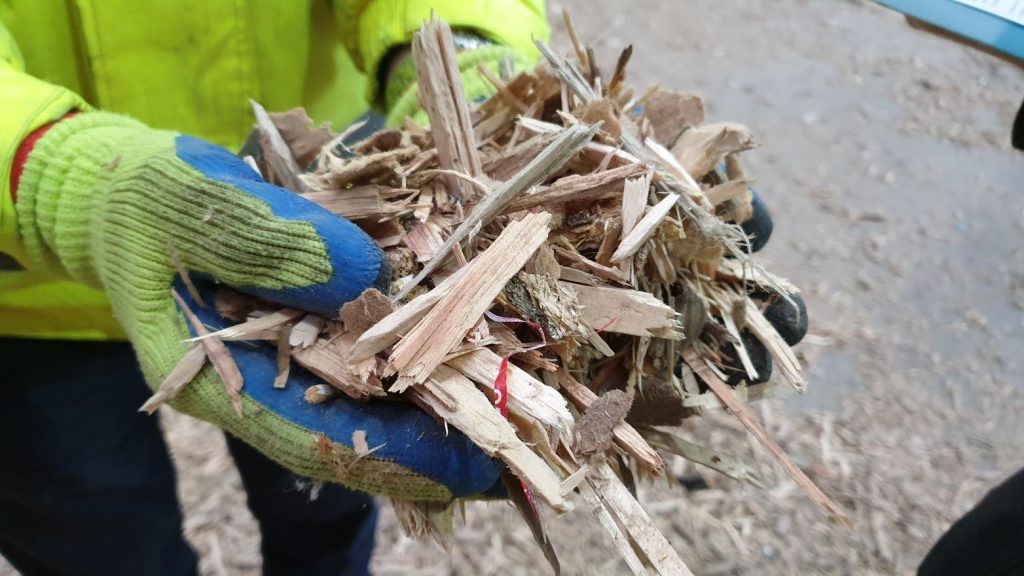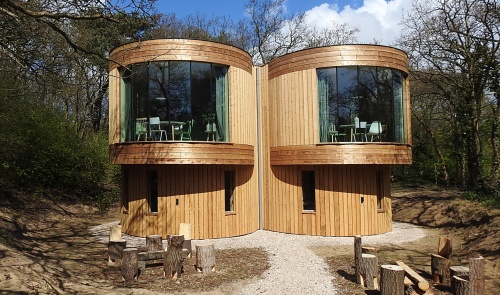
By Dan Ridley-Ellis and Marlene Cramer
Most people think about wood as an abundant, renewable material – and, as long as we replant, the more we use the more we save the planet.
As a wood scientist, who reads about growing wood consumption, examples of poor forest management and wasteful timber use everyday, I am getting quite the opposite impression.
Recently, an interesting article, “Seeing the wood in the forests”, by Lauri Hetemäki, Marc Palahí and Robert Nasi has been published by the European Forest Institute. It puts these two views into perspective by capturing the big picture of global timber consumption.
The report focusses on the urgent need to change the current economic model to a more sustainable, circular economy. It describes timber as a key resource for this transition – since it is linked to forests as an ecosystem on the one hand, and makes an environmental friendly material for various purposes on the other.
“Wood, the most versatile renewable material on earth, will play a key role [in the transition towards a circular bioeconomy]”
“However, it is important to emphasise that the most immediate means for a sustainable future is reducing consumption.”
Seeing the wood in the forests, page 3
The main goal of the publication is to highlight developments and likely future trends in the global timber consumption, and to give perspective and recommendations on how to ensure the sustainability of our future wood use. The report gives a global overview of these topics, but I was interested to reflect on how the UK fits into the picture.
Roundwood production and demand
“Given the world population and middle-income class growth, and the need to replace fossil and non-renewable raw materials, products and energy, it is important to assess to what extent wood could provide more sustainable alternative.”
Seeing the wood in the forests, page 4
The report states that the global roundwood production had been steadily increasing between 1961 and 1990, then reached a period of stagnation, and then started slowly growing again in 2010. However, between 1990 and 2018 the overall gain in production was only 10%.
Over the same period, the UK roundwood production increased by nearly 80% from 6.5 million green tonnes in 1990 to 11.6 million tonnes in 2018 [1]. This is largely a result of government incentives and afforestation efforts. It follows a trend that started after the first world war, when wood shortages due to large historical deforestation limited timber supply [2]. But of course, this is timber once it has reached harvest age – and what we are benefiting from here was a boom in tree planting in the years between 1947 and 1975, and the boost in forest productivity that came thanks to fast-growing plantations under management focussing on volume – sometimes to the detriment of the environment.

But, we reap what we sow, and it is no more possible to go back in time a few decades to plant more trees than it is to go back millions of years to bury more oil. The recent years of new planting in the UK have been …almost negligible… and although it is good news that tree planting is back high on the political agenda there is huge public debate over what kind of trees should be planting and for what purpose. The kind of forestry that delivered this recent benefit in wood is not popular – even among commercial foresters who learned from the mistakes of the past…but it would be equally wrong to plant without proper thought to the wood we will need in future and how best we can provide it.
The EFI report further describes that most roundwood is harvested in Europe and North America, where sustainability is in focus of modern forestry operations. The typical harvest rates (wood that is removed as a percentage of wood that is re-growing) lie between 30 and 80% worldwide, according to the authors. (There is deforestation of course, but the main causes of that are not wood harvesting these days).
The UK figure from 2015 with 63% [3] is very close to the EU average of 65%. Increasing harvest rates much more than this is not desirable in terms of resilience of the supply chain and preservation of ecosystems – the forests need a little extra, and a rate of 70% is often quoted as the limit.
In addition, the other methods that increase the productivity of forests might reduce biodiversity and functionality of ecosystems. For example, removing branches, leaves and roots for biomass instead of leaving them in the forest was found to have a negative impact on the ecosystem and it is recommended to leave at least 25-33% of residues in the forest [4]. The same is true for more efficient but less natural forestry management techniques, which is why more productive plantations cannot replace natural forest.
Hetemäki, Palahí and Nasi do not, however, suggest that the productivity of forests needs to drastically increase to meet the growing global demand. They argue that a shift to a bioeconomy that highly values sustainability principles would provoke improved forest management and prevent illegal logging, especially in countries where production is less intensive to date. Examples are Russia and China, where harvest rates currently do not exceed 30%. They show that 90% of the projected “business as usual” increase of global roundwood consumption up to 2050 could be supplied by Russia if the country adjusted the harvest rate to the EU level of 65%. They point out, of course, that it is not just up to Russia – that this is a purely hypothetical scenario to illustrate scale – and that many countries will contribute to the actual roundwood supply.
The UK however, will not make a meaningful contribution to the global roundwood production. The country has long been dependent on imports and will continue to import more than the local production because consumption is so high. The best the UK can hope for is to provide an increased proportion of its own wood needs – the current figure is about 20%.
It is worth also pausing to remind ourselves that the “business as usual” scenario is not ideal. We need to also provide a bigger proportion of our needs from wood – and this isn’t the business as usual 12% increase by 2050. Nobody really knows – but perhaps it would be closer to the WWF’s Living Forest Model quadrupling!
Wood as biomass
The report’s authors observe that more than half of the roundwood was used as fuel for many years, but as a decreasing proportion – and that in 2018 there was (slightly) more industrial roundwood than fuel wood. Industrial roundwood has risen from the 40% share in 1961 to slightly more than 50% in 2018.

In the UK, and in Europe in general, this trend has been the opposite. The UK wood fuel production has increased from 3.1% of total roundwood production in 1994 to 22.5% in 2018. In addition, the wood pellet imports of the UK have been rising in the past years and exceeded 7 million tonnes [5] in 2018 which is around 26% of world production [6].
According to the report’s authors, the problematic consumption of wood fuel happens mainly in Africa, China, and India, where incineration is not regulated, and wood is often burnt using inefficient technologies with significant health and environmental impacts – especially for indoor air quality. In Europe and North America modern technology is in more common use, that converts biomass to heat and electricity much more efficiently. The authors see the less developed countries adopting these, and other renewable energy solutions (they also mention natural gas). The authors don’t see a problem in Europe’s approach to reach its renewable energy goals by increasing biomass use – although they do say they expect solar and wind energy to increase.
But the UK biomass energy sector is more and more under public criticism, since long transport routes and growing use of virgin wood as biomass makes the energy source unsustainable by some measures, and rubs up against both environmentalist ideals and the commercial interests of the fossil fuel sector. High profile studies show that energy produced from wood pellets imported from North America can emit more greenhouse gases than energy produced from coal, in different harvesting scenarios and requires up to 0.96 MWh production energy per MWh that is produced [7]. For sure it is not simple, but the avoidable use of virgin timber for energy recovery prevents an efficient, circular timber use and contradicts the circular economy principles.
More recently the UK seemed to steer off the course of increasing biomass energy use, by decreasing allowable greenhouse gas emissions and making incentives for new production plants less available [8]. The new policy reduced allowable greenhouse gas emissions for biomass resulting from production and transport in new biomass energy plants to a level that wood biomass from North America (our normal source) is very unlikely to meet. But this new policy only applies to plants built after the 1st of April 2021 and the demand of wood pellets is projected to rise in the coming years nonetheless. At the smaller end of the scale, it seems likely that we will see more restrictions on small scale wood burning for reasons of air quality and health.
Pulp and Paper
The report continues to describe the projected future roundwood consumption in different industries. The trends in global paper consumption are analysed and it is found that the demand in packaging paper is rising, while graphic paper demand is drastically declining. This development is projected to continue in the same way, since graphic paper is more and more replaced by online resources and packaging paper consumption is linked to the growing popularity of online shopping.
The UK’s paper production has been declining more drastically than the global one – although this has been due to market competition from imports as well as decreasing demand and increased recycling. Between 1990 and 2018 the production of graphic paper, including newsprint, shrank from 2.1 million tonnes to 962,000 tonnes [9]. As shown in the report, the global production of graphic papers only started to decline from 2007 and has since reached roughly the level of 1990. Packaging paper production in the UK has been stable between 1990 and 2018 (2.0 vs 1.9 million tonnes produced) [10] while, worldwide, it grew by ca. 30% between 2000 and 2016. The decline of the pulp and paper sector in the UK was accompanied by a drastic fall in the use of home grown hardwood compared to softwood – again due to market competition from imports. In 1990, 14.8% of the roundwood production was hardwood while in 2018 it was only 1.1% [11]. This has been to the detriment of the diversity of the UK’s forests (around 50% of the conifer trees are Sitka spruce) and hardwood forests today are mostly undermanaged (which also has bad consequences for tree pests and diseases). Of course, the decline in paper consumption is an overall positive trend nonethelsess.
“There is growing demand for some traditional products, such as pulp,
Seeing the wood in the forests, page 7
tissue paper and packaging paper. The most significant increase in forest based product markets, however, are expected to include innovative, engineered wood products in the construction sector, pulp used for textiles, chemicals, bioplastics and energy, and for a number of small niche markets…”
But we need to remember that wood is not a generic material. We cannot simply fix a rise in roundwood demand for one sector with a fall in demand from another. Some sectors have very specific requirements on the type of wood they use. Perhaps this is something we have not really felt yet in the UK because we were able to switch our roundwood from paper to structural timber and panels.
Timber construction

An important timber market, now and in the future, is the construction sector. The report describes the timber construction sector with mass timber products like CLT as one of the most promising timber markets to grow in the future – with a positive impact to make on the transition to a sustainable economy. The authors say that if new houses in Europe were entirely built using timber construction (which of course does not mean that 100% of building material is timber and is also not a realistic scenario), then the entire current roundwood production of Europe would be needed just for this. The authors hope for a revolution in the construction sector that makes it more productive and more environmentally friendly through the use of prefabricated, innovative timber structures. According to the authors between 1.3 and 1.6 times less CO2 is emitted when using timber instead of other construction materials.
The current share of newly constructed timber buildings in the UK is about 25% [12]. Modern methods of construction (which include prefabrication and often engineered timber products) are gaining importance and are encouraged by the government to increase construction productivity. The share of new timber buildings is slowly increasing, but in times of economic instability builders tend to rely on traditional masonry construction more [13], so the revolution of the construction sector seems to be dependent on the stability of the economy. This means there will be changes in the construction sector, but it is hard to predict how quickly the transition will happen (especially after the current crisis). A significant amount of timber will be needed for building construction in the future, keeping in mind that currently 50% of raw materials produced worldwide are used for this purpose. But the use of timber in construction can indeed store carbon for a long time, and the possibility of a cascading use after the first life in a building makes timber even more favourable as a building material.
Wood-based textiles
Another sector that is described in the report as being of high importance in the transition to a sustainable bioeconomy, is the textile industry. It states that currently 10% of all carbon emissions are produced by the sector and that using wood cellulose in textile production can reduce emissions by a factor of 5. It further says that an increase from the current 10% wood-based fibre in the global textile production up to 50% would require roughly 15% of the 2017 global roundwood production. The authors hope on innovation in both textile production from wood fibres and global forestry activities that improve productivity to satisfy this demand.
In volume terms, the UK plays an insignificant role in the global textile production with approximately 0.3% of total textile mass produced [14]. The industry in the UK is focused on high-value niche products and wool processing. Slightly more of interest is the consumption of textiles in the UK, which takes around 2.1% of global production [15]. So more than the industry, consumer choices will have an impact on the development of this sector. There is a high potential for consumers to reduce their textile consumption, mainly by buying fewer clothes (35 kg of textiles are consumed every year by an average UK citizen [16]) and clothes of higher quality that last longer. Clothes recycling and reuse could be enhanced as well, since currently around 300,000 tonnes of clothes are sent to landfill annually [17].
Other uses
The article further outlines the importance of innovative branches of the timber supply chain, that according to the authors, will play an increasing role in diverse industry sectors. Lignin, bioethanol and other chemical products can be manufactured from residues and by-products and make a positive contribution to climate goals without increasing roundwood consumption (see also our wood extractives database).
The UK can surely contribute to this goal by developing innovative, material efficient applications for timber and residues. The UK government, research institutes and universities are highly interested in making the economy more circular and minimising negative environmental impacts. There are already some positive results of research and innovation in circular timber use in the recent years. An MDF recovery system has been developed and is in its prototype stage, the University College London started developing cross laminated timber from secondary sources and the INFutUReWood project is currently working to enable the reuse of timber in construction.
Conclusion
Summarizing all these trends in wood consumption, the article concludes that even with growing demands in some industries, the global roundwood production doesn’t need to increase drastically, since material production and use will be more efficient in the future, and consumption in some sectors is declining. This means that a (slightly) growing global roundwood demand does not necessarily clash with a sustainable, responsible timber use. Since timber is unarguably an important material to drive the transition to a circular bioeconomy, it needs to be used in an efficient, circular and innovative way, the authors conclude.
This summary gives hope to the pessimistic wood scientists in this world, but looking at the developments in the UK (that to some extent resemble the ones in Europe),we see flaws in the optimism again. We see a rising consumption in wood biomass and structural timber. While mass timber construction as an ecological building method with high potential for material circularity and long time carbon storage sees a slow uptake, the biomass energy sector boomed in the recent years thanks to government incentives.
The article only focuses on the developments until 2050 and fails to address that short-term “green” solutions, in countries that are trying to fight climate change, are not sustainable in the long term. The biomass issue might be much more pressing in Africa, China and India, but shouldn’t the EU and other highly developed countries like the UK be pioneers in sustainability and circularity? And shouldn’t we aim for solutions that can supply the whole world with sustainable materials instead of only Europe and North America? Yes, it is important to meet short-term goals like emission levels, renewable energy shares and material needs in 2050, but the focus should lie on a long-term strategy. The UK and other countries that have the resources to drive the transition to a circular economy need to spur innovation, accelerate the transition, and share solutions for a truly sustainable future with the rest of the world.
[1] Forestry Facts and Figures 2019, Forest Research
[2] The history of the Forestry Commission (Forestry England website)
[7] Department of Energy and Climate Change 2014
[10] Ibid.
[11] Ibid.
[13] Ibid.
[14] Ecochic and Allwood et al. 2006
[15] Ibid.

Leave a Reply
You must be logged in to post a comment.